| Oracle® Complex Event Processing CQL Language Reference 11g Release 1 (11.1.1) Part Number E12048-03 |
|
|
View PDF |
| Oracle® Complex Event Processing CQL Language Reference 11g Release 1 (11.1.1) Part Number E12048-03 |
|
|
View PDF |
You select, process, and filter element data from streams and relations using Oracle CQL queries and views.
A top-level SELECT statement that you create using the QUERY statement is called a query.
A top-level VIEW statement that you create using the VIEW statement is called a view (the Oracle CQL equivalent of a subquery).
A join is a query that combines rows from two or more streams, views, or relations.
This chapter describes:
Section 17.1, "Introduction to Oracle CQL Queries, Views, and Joins"
Section 17.5, "Oracle CQL Queries and the Oracle CEP Server Cache"
Section 17.6, "Oracle CQL Queries and Relational Database Tables"
Section 17.7, "Oracle CQL Queries and Oracle Data Cartridges"
For more information, see:
An Oracle CQL query is an operation that you express in Oracle CQL syntax and execute on an Oracle CEP CQL Processor to process data from one or more streams or views. For more information, see Section 17.2, "Queries".
An Oracle CQL view represents an alternative selection on a stream or relation. In Oracle CQL, you use a view instead of a subquery. For more information, see Section 17.3, "Views".
Oracle CEP performs a join whenever multiple streams appear in the FROM clause of the query. For more information, see Section 17.4, "Joins".
Example 17-1 shows typical Oracle CQL queries defined in an Oracle CQL processor component configuration file for the processor named proc.
Example 17-1 Typical Oracle CQL Query
<?xml version="1.0" encoding="UTF-8"?>
<n1:config
xsi:schemaLocation="http://www.bea.com/ns/wlevs/config/application wlevs_application_config.xsd"
xmlns:n1="http://www.bea.com/ns/wlevs/config/application"
xmlns:xsi="http://www.w3.org/2001/XMLSchema-instance">
<processor>
<name>proc</name>
<rules>
<view id="lastEvents" schema="cusip mbid srcId bidQty ask askQty seq"><![CDATA[
select cusip, mod(bid) as mbid, srcId, bidQty, ask, askQty, seq
from filteredStream[partition by srcId, cusip rows 1]
]]></view>
<query id="q1"><![CDATA[
SELECT *
FROM lastEvents [Range Unbounded]
WHERE price > 10000
]]></query>
</rules>
</processor>
</n1:config>
As Example 17-1 shows, the rules element contains each Oracle CQL statement in a view or query child element:
view: contains Oracle CQL view statements (the Oracle CQL equivalent of subqueries). The view element id attribute defines the name of the view.
In Example 17-1, the view element specifies an Oracle CQL view statement (the Oracle CQL equivalent of a subquery).
query: contains Oracle CQL select statements. The query element id attribute defines the name of the query.
In Example 17-1, the query element specifies an Oracle CQL query statement. The query statement selects from the view. By default, the results of a query are output to a down-stream channel. You can control this behavior in the channel configuration using a selector element.
For more information, see "How to Configure a Channel in the Default Component Configuration File Using Oracle CEP IDE for Eclipse" in the Oracle CEP Developer's Guide for Eclipse.
Each Oracle CQL statement is contained in a <![CDATA[ ... ]]> tag and does not end in a semicolon (;).
For more information, see:
Typically, you create an Oracle CQL query or view using the Oracle CEP IDE for Eclipse. After deployment, you can add, change, and delete Oracle CQL queries using the Oracle CEP Visualizer.
To create an Oracle CQL query:
Using Oracle CEP IDE for Eclipse, create an Oracle CEP application and Event Processing Network (EPN).
For more information, see:
"Oracle CEP IDE for Eclipse Projects" in the Oracle CEP Developer's Guide for Eclipse.
"Oracle CEP IDE for Eclipse and the Event Processing Network" in the Oracle CEP Developer's Guide for Eclipse.
In the EPN Editor, right-click an Oracle CQL processor and select Go to Configuration Source as Figure 17-1 shows.
Figure 17-1 Navigating to the Configuration Source of a Processor from the EPN Editor
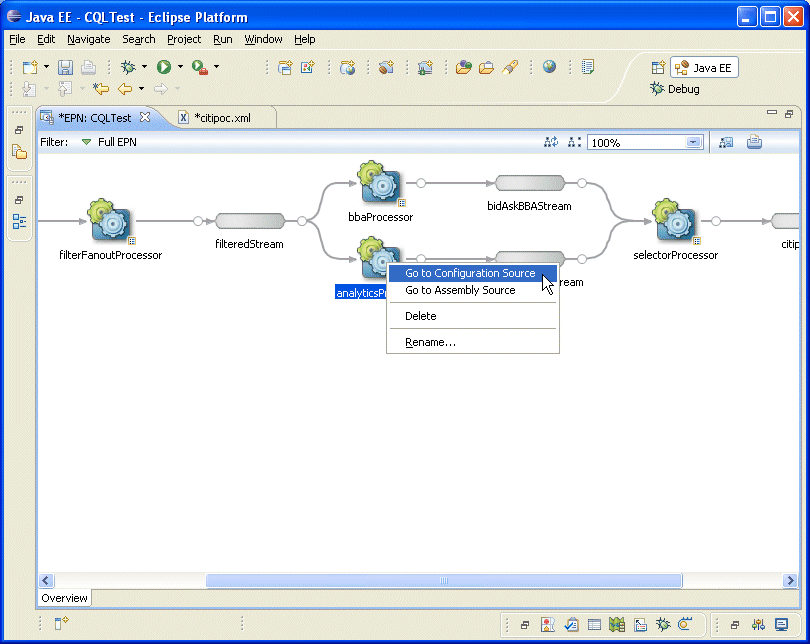
The EPN Editor opens the corresponding component configuration file for this processor and positions the cursor in the appropriate processor element as Figure 17-2 shows.
Figure 17-2 Editing the Configuration Source for a Processor
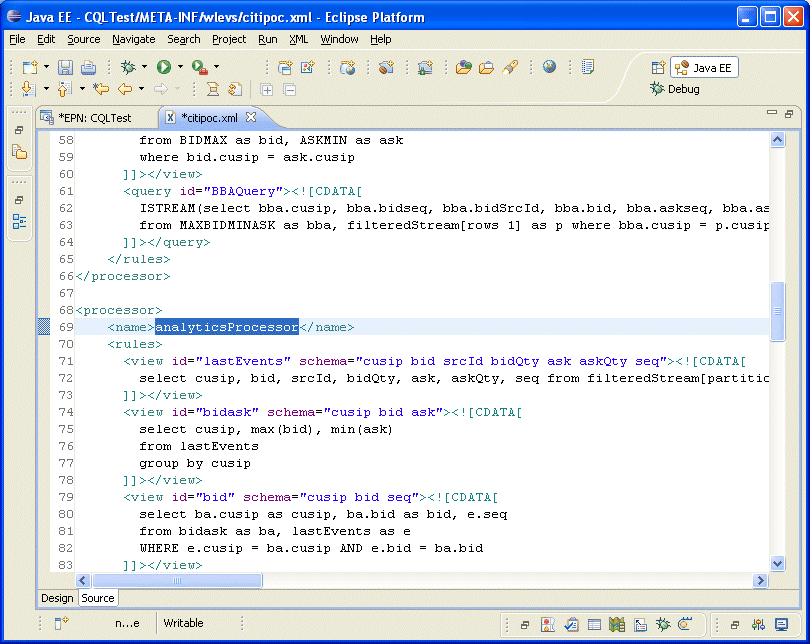
Create queries and views and register user-defined functions and windows.
For examples, see
Using Oracle CEP IDE for Eclipse, package your Oracle CEP application and deploy to the Oracle CEP server.
For more information, see "Assembling and Deploying Oracle CEP Applications" in the Oracle CEP Developer's Guide for Eclipse.
After deployment, use the Oracle CEP Visualizer to change, add, and delete queries in the Oracle CEP application.
For more information, see "Managing Oracle CQL Rules" in the Oracle CEP Visualizer User's Guide.
Queries are the principle means of extracting information from data streams and views.
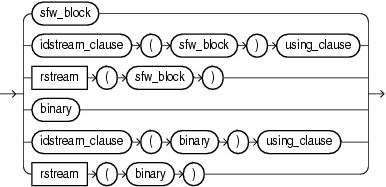
The query clause itself is made up of one of the following parts:
sfw_block: use this select-from-where clause to express a CQL query.
For more information, see Section 17.2.1.1, "Select, From, Where Block".
idstream_clause: use this clause to specify an input IStream or delete DStream relation-to-stream operator that applies to the query.
For more information, see Section 17.2.1.9, "IDStream Clause"
rstream: use this clause to specify an RStream relation-to-stream operator that applies to the query.
For more information, see "RStream Relation-to-Stream Operator"
binary: use this clause to perform set operations on the tuples that two queries or views return.
For more information, see Section 17.2.1.8, "Binary Clause"
The following sections discuss the basic query types that you can create:
For more information, see:
This section summarizes the basic building blocks that you use to construct an Oracle CQL query, including:
Use the sfw_block to specify the select, from, and optional where clauses of your Oracle CQL query.
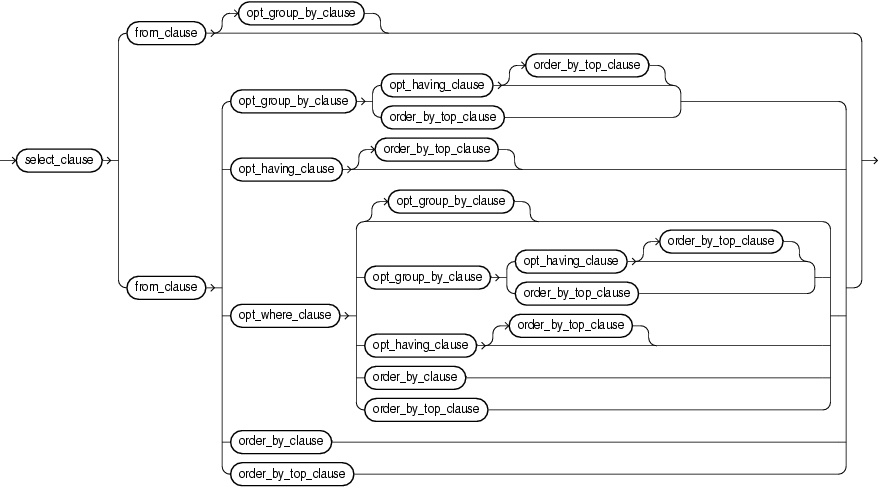
The sfw_block is made up of the following parts:
Use this clause to specify the stream elements you want in the query's result set. The select_clause may specify all stream elements using the * operator or a list of one or more stream elements.

The list of expressions that appears after the SELECT keyword and before the from_clause is called the select list. Within the select list, you specify one or more stream elements in the set of elements you want Oracle CEP to return from one or more streams or views. The number of stream elements, and their datatype and length, are determined by the elements of the select list.
Optionally, specify distinct if you want Oracle CEP to return only one copy of each set of duplicate tuples selected. Duplicate tuples are those with matching values for each expression in the select list.
For more information, see select_clause::=
Use this clause to specify the streams and views that provide the stream elements you specify in the select_clause (see Section 17.2.1.2, "Select Clause").
The from_clause may specify one or more comma-delimited relation_variable clauses.

For more information, see from_clause::=
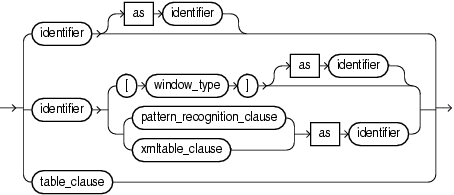
You can select from any of the data sources that your relation_variable clause specifies.
You can use the relation_variable clause AS operator to define an alias to label the immediately preceding expression in the select list so that you can reference the result by that (see Section 2.8.1.1, "Aliases in the relation_variable Clause").
If you create a join (see Section 17.4, "Joins") between two or more streams, view, or relations that have some stream element names in common, then you must qualify stream element names with the name of their stream, view, or relation. Example 17-2 shows how to use stream names to distinguish between the customerID stream element in the OrderStream and the customerID stream element in the CustomerStream.
Example 17-2 Fully Qualified Stream Element Names
<query id="q0"><![CDATA[
select * from OrderStream, CustomerStream
where
OrderStream.customerID = CustomerStream.customerID
]]></query>
Otherwise, fully qualified stream element names are optional. However, Oracle recommends that you always qualify stream element references explicitly. Oracle CEP often does less work with fully qualified stream element names.
For more information, see:
Use this optional clause to specify conditions that determine when the select_clause returns results (see Section 17.2.1.2, "Select Clause").
Because Oracle CQL applies the WHERE clause before GROUP BY or HAVING, if you specify an aggregate function in the SELECT clause, you must test the aggregate function result in a HAVING clause, not the WHERE clause.
For more information, see:
Use this optional clause to group (partition) results. This clause does not guarantee the order of the result set. To order the groupings, use the order by clause.
Because Oracle CQL applies the WHERE clause before GROUP BY or HAVING, if you specify an aggregate function in the SELECT clause, you must test the aggregate function result in a HAVING clause, not the WHERE clause.
For more information, see:
Use this optional clause to order all results or the top-n results.
For more information, see:
Use this optional clause to restrict the groups of returned stream elements to those groups for which the specified condition is TRUE. If you omit this clause, then Oracle CEP returns summary results for all groups.
Because Oracle CQL applies the WHERE clause before GROUP BY or HAVING, if you specify an aggregate function in the SELECT clause, you must test the aggregate function result in a HAVING clause, not the WHERE clause.
For more information, see:
Use the binary clause to perform set operations on the tuples that two queries or views return, including:
EXCEPT
MINUS
INTERSECT
UNION and UNION ALL
IN and NOT IN
For more information, see binary::=.
Use this clause to take either a select-from-where clause or binary clause and return its results as one of IStream or DStream relation-to-stream operators.
You can succinctly detect differences in query output by combining an IStream or Dstream operator with the using_clause.
For more information, see:
Example 17-3 shows a simple query that selects all stream elements from a single stream.
Example 17-3 Simple Query
<query id="q0"><![CDATA[
select * from OrderStream where orderAmount > 10000.0
]]></query>
For more information, see "Query".
Example 17-4 shows a query that selects all stream elements from stream S2, with schema (c1 integer, c2 float), using a built-in tuple-based stream-to-relation window operator.
Example 17-4 Built-In Window Query
<query id="BBAQuery"><![CDATA[
create query q209 as select * from S2 [range 5 minutes] where S2.c1 > 10
]]></query>
For more information, see:
Example 17-5 shows a query that uses the MATCH_RECOGNIZE clause to express complex relationships among the stream elements of ItemTempStream.
Example 17-5 MATCH_RECOGNIZE Query
<query id="detectPerish"><![CDATA[
select its.itemId
from tkrfid_ItemTempStream MATCH_RECOGNIZE (
PARTITION BY itemId
MEASURES A.itemId as itemId
PATTERN (A B* C)
DEFINE
A AS (A.temp >= 25),
B AS ((B.temp >= 25) and (to_timestamp(B.element_time) - to_timestamp(A.element_time) < INTERVAL "0 00:00:05.00" DAY TO SECOND)),
C AS (to_timestamp(C.element_time) - to_timestamp(A.element_time) >= INTERVAL "0 00:00:05.00" DAY TO SECOND)
) as its
]]></query>
For more information, see:
Using an Oracle CQL processor, you can specify a relational database table as an event source. You can query this event source, join it with other event sources, and so on.
For example, assume that you create the table you want to access using the SQL statement that Example 17-6 shows.
Example 17-6 Table Create SQL Statement
create table Stock (symbol varchar(16), exchange varchar(16));
After configuration, you can define Oracle CQL queries that access the Stock table as if it was just another event stream. Example 17-7 shows a query that joins one event stream ExchangeStream with the Stock table:
Example 17-7 Oracle CQL Query on Relational Database Table Stock
SELECT ExchangeStream.symbol, ExchangeStream.price, Stock.exchange FROM ExchangeStream [Now], Stock WHERE ExchangeStream.symbol = Stock.symbol
Oracle CEP relational database table event sources are pull data sources: that is, Oracle CEP will periodically poll the event source.
Note:
Because changes in the table source are not coordinated in time with stream data, you may only use aNow window. For more information, see "S[now]".For more information, see:
"Configuring Access to a Relational Database" in the Oracle CEP Administrator's Guide
"Configuring an Oracle CQL Processor Table Source" in the Oracle CEP Developer's Guide for Eclipse
Example 17-8 shows a view v1 and a query q1 on that view. The view selects from a stream S1 of xmltype stream elements. The view v1 uses the XMLTABLE clause to parse data from the xmltype stream elements using XPath expressions. Note that the data types in the view's schema match the datatypes of the parsed data in the COLUMNS clause. The query q1 selects from this view as it would from any other data source. The XMLTABLE clause also supports XML namespaces.
Example 17-8 XMLTABLE Query
<view id="v1" schema="orderId LastShares LastPrice"><![CDATA[
select
X.OrderId,
X.LastShares,
X.LastPrice
from
S1
XMLTABLE (
"//FILL"
PASSING BY VALUE
S1.c1 as "."
COLUMNS
OrderId char(16) PATH "fn:data(../@ID)",
LastShares integer PATH "fn:data(@LastShares)",
LastPrice float PATH "fn:data(@LastPx)"
) as X
]]></view>
<query id="q1"><![CDATA[
IStream(
select
orderId,
sum(LastShares * LastPrice),
sum(LastShares * LastPrice) / sum(LastShares)
from
v1[now]
group by orderId
)
]]></query>
For more information, see:
Use the TABLE clause to access the multiple rows returned by a built-in or user-defined function in the FROM clause of an Oracle CQL query. The TABLE clause converts the set of returned rows into an Oracle CQL relation. Because this is an external relation, you must join the TABLE function clause with a stream.
(object_expr::=, identifier::=, datatype::=)
Note the following:
The function must return an array type or Collection type.
You must join the TABLE function clause with a stream.
Example 17-9 shows a data cartridge TABLE clause that invokes the Oracle Spatial data cartridge method getContainingGeometries, passing in one parameter (InputPoints.point). The return value of this method, a Collection, is aliased as validGeometries. The relation that the TABLE clause returns is aliased as R2.
Example 17-9 Data Cartridge TABLE Query
<query id="q1"><![CDATA[
RSTREAM (
SELECT
R2.validGeometries.shape as containingGeometry,
R1.point as inputPoint
FROM
InputPoints[now] as R1,
TABLE (getContainingGeometries@spatial (InputPoints.point) as validGeometries) AS R2
)
]]></query>
Example 17-10 shows an invalid data cartridge TABLE query that fails to join the data cartridge TABLE clause with another stream because the function getAllGeometries@spatial was called without any parameters. Oracle CEP invokes the data cartridge method only on the arrival of elements on the joined stream.
Example 17-10 Invalid Data Cartridge TABLE Query
<query id="q2"><![CDATA[
RSTREAM (
SELECT
R2.validGeometries.shape as containingGeometry
FROM
TABLE (getAllGeometries@spatial () as validGeometries) AS R2
)
]]></query>
For more examples, see:
For more information, see:
Using an Oracle CQL processor, you can specify a cache as an event source. You can query this event source and join it with other event sources using a Now window only.
Oracle CEP cache event sources are pull data sources: that is, Oracle CEP will periodically poll the event source.
For more information, see Section 17.5, "Oracle CQL Queries and the Oracle CEP Server Cache".
Use the ORDER BY clause to order the rows selected by a query.
Sorting by position is useful in the following cases:
To order by a lengthy select list expression, you can specify its position in the ORDER BY clause rather than duplicate the entire expression.
For compound queries containing set operators UNION, INTERSECT, MINUS, or UNION ALL, the ORDER BY clause must specify positions or aliases rather than explicit expressions. Also, the ORDER BY clause can appear only in the last component query. The ORDER BY clause orders all rows returned by the entire compound query.
The mechanism by which Oracle CEP sorts values for the ORDER BY clause is specified by your Java locale.
Use the DIFFERENCE USING clause to succinctly detect differences in the IStream or DStream of a query.
Consider the query that Example 17-11 shows.
Example 17-11 DIFFERENCE USING Clause
<query id="q0">
ISTREAM (
SELECT c1 FROM S [RANGE 1 NANOSECONDS]
) DIFFERENCE USING (c1)
</query>
Table 17-1 shows sample input for this query. The Relation column shows the contents of the relation S [RANGE 1 NANOSECONDS] and the Output column shows the query results after the DIFFERENCE USING clause is applied. This clause allows you to succinctly detect only differences in the IStream output.
Table 17-1 DIFFERENCE USING Clause Affect on IStream
| Input | Relation | Output |
|---|---|---|
|
|
|
|
|
|
|
|
|
|
|
|
|
|
|
|
|
|
|
|
|
|
|
|
|
|
|
|
|
|
|
|
|
|
|
|
|
|
|
|
|
|
|
|
|
|
|
|
|
|
|
|
|
|
|
|
|
|
|
|
|
|
|
|
|
|
|
|
When you specify the usinglist in the DIFFERENCE USING clause, you may specify columns by:
attribute name: use this option when you are selecting by attribute name.
Example 17-12 shows attribute name c1 in the DIFFERENCE USING clause usinglist.
alias: use this option when you want to include the results of an expression where an alias is specified.
Example 17-12 shows alias logval in the DIFFERENCE USING clause usinglist.
position: use this option when you want to include the results of an expression where no alias is specified.
Specify position as a constant, positive integer starting at 1, reading from left to right.
Example 17-12 specifies the result of expression funct(c2, c3) by its position (3) in the DIFFERENCE USING clause usinglist.
Example 17-12 Specifying the usinglist in a DIFFERENCE USING Clause
<query id="q1">
ISTREAM (
SELECT c1, log(c4) as logval, funct(c2, c3) FROM S [RANGE 1 NANOSECONDS]
) DIFFERENCE USING (c1, logval, 3)
</query>
You can use the DIFFERENCE USING clause with both IStream and DStream operators.
For more information, see:
Queries are the principle means of extracting information from data streams and relations. A view represents an alternative selection on a stream or relation that you can use to create subqueries.
A view is only accessible by the queries that reside in the same processor and cannot be exposed beyond that boundary.
You can specify any query type in the definition of your view. For more information, see Section 17.2, "Queries".
For complete details on the view statement, see "View".
In Example 17-13, query BBAQuery selects from view MAXBIDMINASK which in turn selects from other views such as BIDMAX which in turn selects from other views. Finally, views such as lastEvents select from an actual event source: filteredStream. Each such view represents a separate derived stream drawn from one or more base streams.
Example 17-13 Using Views Instead of Subqueries
<view id="lastEvents" schema="cusip bid srcId bidQty ask askQty seq"><![CDATA[
select cusip, bid, srcId, bidQty, ask, askQty, seq
from filteredStream[partition by srcId, cusip rows 1]
]]></view>
<view id="bidask" schema="cusip bid ask"><![CDATA[
select cusip, max(bid), min(ask)
from lastEvents
group by cusip
]]></view>
<view id="bid" schema="cusip bid seq"><![CDATA[
select ba.cusip as cusip, ba.bid as bid, e.seq
from bidask as ba, lastEvents as e
WHERE e.cusip = ba.cusip AND e.bid = ba.bid
]]></view>
<view id="bid1" schema="cusip maxseq"><![CDATA[
select b.cusip, max(seq) as maxseq
from bid as b
group by b.cusip
]]></view>
<view id="BIDMAX" schema="cusip seq srcId bid bidQty"><![CDATA[
select e.cusip, e.seq, e.srcId, e.bid, e.bidQty
from bid1 as b, lastEvents as e
where (e.seq = b.maxseq)
]]></view>
<view id="ask" schema="cusip ask seq"><![CDATA[
select ba.cusip as cusip, ba.ask as ask, e.seq
from bidask as ba, lastEvents as e
WHERE e.cusip = ba.cusip AND e.ask = ba.ask
]]></view>
<view id="ask1" schema="cusip maxseq"><![CDATA[
select a.cusip, max(seq) as maxseq
from ask as a
group by a.cusip
]]></view>
<view id="ASKMIN" schema="cusip seq srcId ask askQty"><![CDATA[
select e.cusip, e.seq, e.srcId, e.ask, e.askQty
from ask1 as a, lastEvents as e
where (e.seq = a.maxseq)
]]></view>
<view id="MAXBIDMINASK" schema="cusip bidseq bidSrcId bid askseq askSrcId ask bidQty askQty"><![CDATA[
select bid.cusip, bid.seq, bid.srcId as bidSrcId, bid.bid, ask.seq, ask.srcId as askSrcId, ask.ask, bid.bidQty, ask.askQty
from BIDMAX as bid, ASKMIN as ask
where bid.cusip = ask.cusip
]]></view>
<query id="BBAQuery"><![CDATA[
ISTREAM(select bba.cusip, bba.bidseq, bba.bidSrcId, bba.bid, bba.askseq, bba.askSrcId, bba.ask, bba.bidQty, bba.askQty, "BBAStrategy" as intermediateStrategy, p.seq as correlationId, 1 as priority
from MAXBIDMINASK as bba, filteredStream[rows 1] as p where bba.cusip = p.cusip)
]]></query>
Using this technique, you can achieve the same results as in the subquery case. However, using views you can better control the complexity of queries and reuse views by name in other queries.
If you create a join between two or more views that have some stream element names in common, then you must qualify stream element names with names of streams. Example 17-14 shows how to use view names to distinguish between the seq stream element in the BIDMAX view and the seq stream element in the ASKMIN view.
Example 17-14 Using View Names to Distinguish Between Stream Elements of the Same Name
<view id="MAXBIDMINASK" schema="cusip bidseq bidSrcId bid askseq askSrcId ask bidQty askQty"><![CDATA[
select bid.cusip, bid.seq, bid.srcId as bidSrcId, bid.bid, ask.seq, ask.srcId as askSrcId, ask.ask, bid.bidQty, ask.askQty
from BIDMAX as bid, ASKMIN as ask
where bid.cusip = ask.cusip
]]></view>
Otherwise, fully qualified stream element names are optional. However, it is a best practice to always qualify stream element references explicitly. Oracle CEP often does less work with fully qualified stream element names.
For more information, see Section 17.4, "Joins".
You may define the optional schema of the view using a space delimited list of event attribute names as Example 17-15 shows.
A join is a query that combines rows from two or more streams, views, or relations. Oracle CEP performs a join whenever multiple streams appear in the FROM clause of the query. The select list of the query can select any stream elements from any of these streams. If any two of these streams have a stream element name in common, then you must qualify all references to these stream elements throughout the query with stream names to avoid ambiguity.
If you create a join between two or more streams, view, or relations that have some stream element names in common, then you must qualify stream element names with the name of their stream, view, or relation. Example 17-16 shows how to use stream names to distinguish between the customerID stream element in the OrderStream stream and the customerID stream element in the CustomerStream stream.
Example 17-16 Fully Qualified Stream Element Names
<query id="q0"><![CDATA[
select * from OrderStream[range 5] as orders, CustomerStream[range 3] as customers where
orders.customerID = customers.customerID
]]></query>
Otherwise, fully qualified stream element names are optional. However, Oracle recommends that you always qualify stream element references explicitly. Oracle CEP often does less work with fully qualified stream element names.
Oracle CEP supports the following types of joins:
Note:
When joining against a cache, you must observe additional query restrictions as Section 17.5.1, "Creating Joins Against the Cache" describes.By default, Oracle CEP performs an inner join (sometimes called a simple join): a join of two or more streams that returns only those stream elements that satisfy the join condition.
Example 17-17 shows how to create a query q4 that uses an inner join between streams S0, with schema (c1 integer, c2 float), and S1, with schema (c1 integer, c2 float).
An outer join extends the result of a simple join. An outer join returns all rows that satisfy the join condition and also returns some or all of those rows from one table for which no rows from the other satisfy the join condition.
You specify an outer join in the FROM clause of a query using LEFT or RIGHT OUTER JOIN ... ON syntax.

(non_mt_relation_list::=, relation_variable::=, non_mt_cond_list::=)
Example 17-18 shows how to create a query q5 that uses a left outer join between streams S0, with schema (c1 integer, c2 float), and S1, with schema (c1 integer, c2 float).
Example 17-18 Outer Joins
<query id="q5"><![CDATA[
SELECT a.c1+b.c1
FROM S0[range 5] AS a LEFT OUTER JOIN S1[range 3] AS b ON b.c2 = a.c2
WHERE b.c2 > 3
]]></query>
Use the ON clause to specify a join condition. Doing so lets you specify join conditions separate from any search or filter conditions in the WHERE clause.
You can perform the following types of outer join:
To write a query that performs an outer join of streams A and B and returns all stream elements from A (a left outer join), use the LEFT OUTER JOIN syntax in the FROM clause as Example 17-19 shows. For all stream elements in A that have no matching stream elements in B, Oracle CEP returns null for any select list expressions containing stream elements of B.
To write a query that performs an outer join of streams A and B and returns all stream elements from B (a right outer join), use the RIGHT OUTER JOIN syntax in the FROM clause as Example 17-20 shows. For all stream elements in B that have no matching stream elements in A, Oracle CEP returns null for any select list expressions containing stream elements of A.
You can create an outer join that refers or looks-back to a previous outer join as Example 17-21 shows.
You can access an Oracle CEP cache from an Oracle CQL statement or user-defined function.
This section describes:
For more information, see:
"Configuring Oracle CEP Caching" in the Oracle CEP Developer's Guide for Eclipse
"Accessing a Cache From an Oracle CQL Statement" in the Oracle CEP Developer's Guide for Eclipse
"Accessing a Cache From an Oracle CQL User-Defined Function" in the Oracle CEP Developer's Guide for Eclipse
"Oracle Continuous Query Language (CQL) Example" in the Oracle CEP Getting Started
When writing Oracle CQL queries that join against a cache, you must observe the following restrictions:
For more information, see Section 17.4, "Joins".
The complex predicate's first subclause (from the left) with a comparison operation over a cache key attribute may only be a simple equality predicate.
The following predicate is invalid because the predicate is not the first sub-clause (from the left) which refers to cache attributes:
... S.c1 = 5 AND CACHE.C2 = S.C2 AND CACHE.C1 = S.C1 ...
However, the following predicate is valid:
... S.c1 = 5 AND CACHE.C1 = S.C1 AND CACHE.C2 = S.C2 ...
The subclause may not have any arithmetic operations on a cache key attribute.
The following predicate is invalid because arithmetic operations are not allowed on cache key attributes:
... CACHE.C1 + 5 = S.C1 AND CACHE.C2 = S.C2 ...
The complex predicate must not require a full scan of the cache.
Assume that your cache has cache key C1.
The following predicates are invalid. Because they do not use the cache key attribute in comparisons, they must scan through the whole cache which is not allowed.
... CACHE.C2 = S.C1 ... ... CACHE.C2 > S.C1 ... ... S.C1 = S.C2 ... ... S.C1 = CACHE.C2 AND S.C2 = CACHE.C2 ...
The following predicates are also invalid. Although they do use the cache key attribute in comparisons, they use inequality operations that must scan through the whole cache which is not allowed.
... CACHE.C1 != S.C1 ... ... CACHE.C1 > 5 ... ... CACHE.C1 + 5 = S.C1 ...
The following predicate is also invalid. Although they do use the cache key attribute in comparisons, the first subclause referring to the cache attributes does not refer to the cache key attribute (in this example, C1). That is, the first subclause refers to C2 which is not a cache key and the cache key comparison subclause (CACHE.C1 = S.C1) appears after the non-key comparison subclause.
... CACHE.C2 = S.C2 AND CACHE.C1 = S.C1 ...
To support multiple conditions, inequality, or both, you must make the first sub-clause an equality predicate comparing a cache key value and specify the rest of the predicate subclauses separated by one AND operator.
The following are valid predicates:
... S.c1 = 5 AND CACHE.C1 = S.C1 AND CACHE.C2 > S.C2 ... ... CACHE.C1 = S.C1 AND CACHE.C2 = S.C2 ... ... S.c1 = 5 AND CACHE.C1 = S.C1 AND CACHE.C2 != S.C2 ...
You can access a relational database table from an Oracle CQL statement.
For a query that joins against a relational database table, Oracle CQL supports all kinds of complex predicates.
For more information, see "Configuring an Oracle CQL Processor Table Source" in the Oracle CEP Developer's Guide for Eclipse.